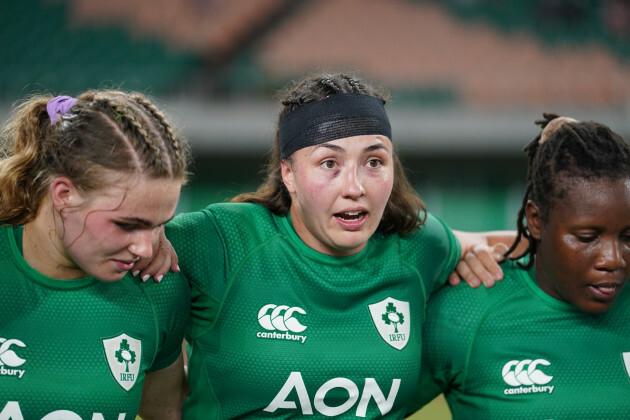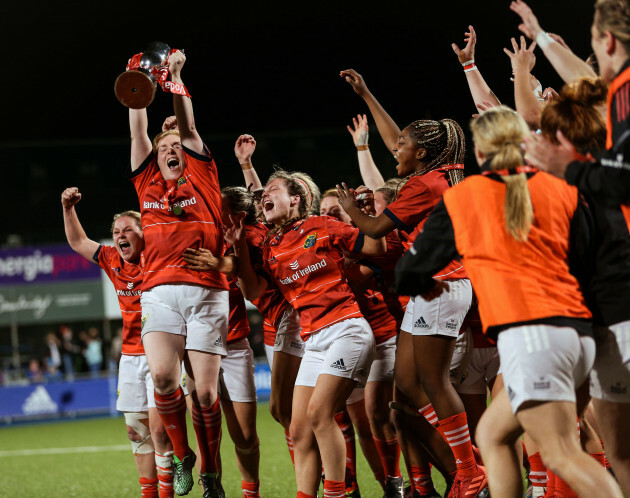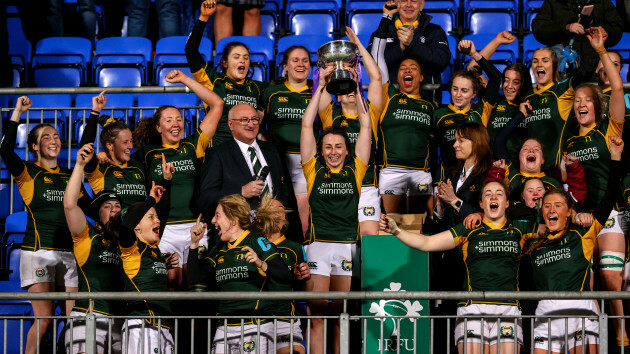ONE PERSON INVOLVED in the game describes Irish women’s rugby as being in a state of flux. Another source heavily invested in the sport says it’s messy when you lift the bonnet. Someone else says it’s crying out for more alignment and it’s hard to argue that point.
So clearly there is work to do, even if recent signs have been very positive. Greg McWilliams’ Ireland have been able to shed much of the toxic negativity that pervaded after last year’s failure to qualify for the World Cup. Promising young players are emerging and Ireland just had their first-ever tour, winning one of two Tests in Japan.
In the coming weeks, contracts will be offered to female 15s players for the first time. And the IRFU has a new ‘head of women’s performance and pathways’ in Gillian McDarby. She has an excellent reputation but is probably well aware that there’s a big job ahead.
The42 set out this week to preview the new Women’s All-Ireland League [AIL] season, which kicks off next Saturday. It might sound like a simple task but things aren’t always straightforward in this sphere. At times, the women’s rugby system is a fractious landscape. Everyone wants the game to grow but different motivations across different layers mean everyone’s not always pulling in the same direction.
For the season ahead, the structure of the domestic game has changed again. So in 2022/23, rather than running across the course of the entire season, the AIL starts next weekend and builds swiftly to semi-finals and a final in December, those play-offs taking place on the same weekends as the Ireland women’s 7s are away for two legs of the World Series.
A new club cup competition begins in early 2023, with the Inter-Provincial Championship played out over four weekends in January and February. Then the top players head into Ireland camp for the Six Nations in March and April, while non-international players finish out the club cup competition.
The IRFU hopes this one-off season plan will ensure its Ireland-based international stars are primed to earn a top-three finish in the Six Nations, which would in turn secure Ireland a place in the top tier of World Rugby’s new WXV international competition that starts in autumn 2023.
There has also been talk of a Celtic Cup competition being squeezed in somewhere, although that may come further into the future. Exactly which teams would represent Irish rugby in that mooted competition against Welsh and Scottish sides is unclear – provinces or clubs? – as is the actual value of playing against the Welsh and Scots.
There have even been mutterings recently about a European Cup competition for women’s rugby coming into play by 2024 with support from World Rugby, but again there is little detail on the make-up or format or which Irish sides would potentially be involved.
Confirmation that the IRFU will offer 43 centralised, paid contracts to female players this season was rightly greeted with excitement recently. That number includes existing 7s contracts, but we’re still looking at over 20 contracts for 15s players. Even this good news is slightly complicated. Contracts aren’t a guaranteed panacea.
Irish players are waiting for offers to arrive from the IRFU over the next few weeks. They will learn how much the contracts are worth and exactly what demands are involved. It’s understood the contracts will range from €18,000 to €30,000, so anyone who already has a successful or developing career away from the sport is extremely unlikely to pack that in to become a full-time rugby player.
Irish players currently based in England are waiting to find out exactly how contracts will work for them and whether they will need to move back home. Some of them are concerned that the AIL isn’t as strong a league as the English Premier 15s, so feel their development is better served by playing club rugby abroad.
The fact is that some Irish players seen as playing professional rugby in England have been earning just a couple of thousand euro per season over there and working outside rugby too, so they stand to improve their levels of remuneration for the time and effort they put into the sport.
The fact that the Ireland internationals are now set to be in a full-time, all-in training camp during periods like the Six Nations thanks to contracting is also excellent for their chances of success. As with the tour to Japan, those windows will essentially now be fully-professional.
One potential issue that could arise is if the newly-contracted players are all asked to be based out of the IRFU’s training centre in Dublin. That would mean every one of the best players in the country being in one location, which would affect the spread of talent in the AIL. In truth, it’s already an issue but it could be further accentuated.
The reality is that the new contracts must be matched by having a thriving domestic game underneath the national team squad. And that remains a work in progress.
So, a sit-down with reigning AIL champions Railway Union to discuss their title defence initially starts with a discussion of the comings and goings in their squad, as well as their pre-season trip to face French club Chilly-Mazarin in Paris yesterday. Railway won on an impressive 28-7 scoreline, which bodes well for their season.
But the conversation rapidly comes around to the season format and the bigger picture. Like some other clubs, Railway are frustrated that the AIL season will wrap up as early as December, with a big group of players potentially missing the final due to 7s duty.
“The highlight of any player’s domestic career is the AIL,” says Railway Union director of rugby, John Cronin.
“Now, Ireland 7s players won’t be able to play the semi-final or final. This is the equivalent of the GAA having the All-Ireland final at the same time as an International Rules tour in Australia.
“It’s only an 11-game league now, so play it at times when everyone is available. Have respect for the league, the clubs, the players.”
Railway captain Niamh Byrne, who won her first Ireland cap in this year’s Six Nations, says players feel it’s very early to be wrapping up the AIL season.
“The Cup has a place, of course, but it’s all about the league. From speaking to other players, not just in my club, everyone agrees that December is too short.
“If it’s going to be on TV and getting coverage, you do want it to be the best and most entertaining game possible.”
The IRFU says all clubs were part of the process of finalising the format for the season and had an avenue to provide feedback on the calendar, although Cronin points out that having a representative from the women’s AIL on the IRFU’s women’s rugby committee would make that process much easier.
The AIL campaign has been condensed into the first half of the season in order for the Inter-Provincial Championship to be played out ahead of the Six Nations. The IRFU’S hope is that Ireland international players will have four weekends of intense competition before going into Six Nations camp.
That may be the case, but long-term questions remain over whether the inter-pro layer of Irish women’s rugby really works.
Its advocates argue that the championship will be of a higher quality than the AIL, pitting all the best players in the country against each other, and can grab wider public attention. Its detractors tell you that there’s little that can be achieved in such a short window of games and that the additional training load is tough on players.
It is worth stressing that many clubs, coaches, and players are big fans of the inter-pros. Representing one’s province is a major honour, but it increasingly feels that the women’s game can’t sustain both a genuine club season and the inter-provincial campaign.
“I don’t see the point of the inter-pros,” says Cronin. “If they were about the player pathway, they wouldn’t allow retired international players to play.
“Also, the country isn’t balanced [in terms of the spread of its best players]. Four of the five top teams in the AIL last season are based in Dublin. Ulster haven’t won a game in the inter-pros in 10 years. Some girls are driving around the country from Dublin, 20 hours a week, to train with the provinces. Is that good for their development?
“I’d love to see the inter-pros only including players in their first three years of adult rugby – so young players and any crossover athletes starting rugby. That would be about development.”
What’s clear is that the season calendar in Irish women’s rugby needs to be nailed down once and for all beyond this season, with careful consideration given to whether the inter-pros work and whether the possible Celtic Cup will provide value.
Ex-women’s director of rugby Anthony Eddy seemingly wanted to shift the whole season forward, starting it every January and allowing top players to peak for the Six Nations and then again for the WXV. It would be a complete departure from the men’s game, but then women’s rugby is a different domain.
It’s thought that Eddy was also in favour of focusing what is a shallow player pool into fewer teams than the current 10 in the AIL. The suggestion of six franchises based in the main population centres around the country makes sense in a lot of ways – particularly from a high performance point of view – but it sounds like the idea wasn’t met with wholesale enthusiasm.
The players have often felt detached from what’s going on behind the scenes. It’s no surprise given that they’re not involved in the decision-making. The IRFU women’s committee still doesn’t include a representative from the women’s AIL clubs.
Ireland 7s and 15s international Amee Leigh Murphy Crowe recently told Rugby Players Ireland magazine, ”I don’t understand committees that are often made up of people at a remove from the field” and added that “surely players need to be at the heart of any decision that ultimately concerns players?”
It’s a message that Byrne echoes.
“Having a women’s AIL rep or a player rep on the women’s committee would be great,” says Byrne.
“Someone in the room has to be able to say how the players feel. Right now, I don’t always think the players are at the centre of it.”
That one simple change doesn’t sound too hard to get sorted and recent evidence shows us that the IRFU is increasingly willing to move quickly.
The will is there from so many quarters in women’s rugby but it’s evident that there is lots of work to do in aligning everything. The sport is moving to another level before our eyes and Irish rugby must grab the opportunity to go with it.
Round 1 of the Women’s AIL:
Saturday 10 September
Old Belvedere v UL Bohemian
Ollie Campbell Park, 3.15pm
Cooke v Suttonians
Clement Wilson Park, 5pm
Galwegians v Ballincollig
Crowley Park, 5pm
Railway Union v Malone
Energia Park, 5pm
Wicklow v Blackrock College
Ashtown Lane, 5pm
– First published 06.30, 4 September




